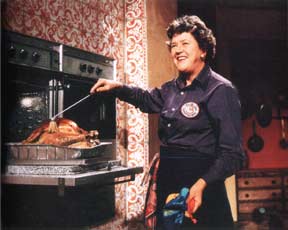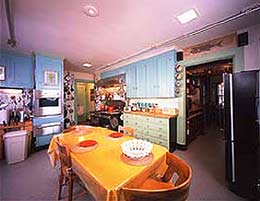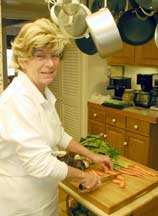|
|
 Thanksgiving à la Julia Child Thanksgiving à la Julia Child
In honor of the cook who spread the gospel of good food to America’s growing middle class, we offer you a Julia Child Thanksgiving.
by Carol Pierini Woller
It’s all about family. Thanksgiving, the quintessential American holiday, is for many people the one time of the year when family and friends assemble to celebrate, feast and give thanks for the many blessings they are privileged to enjoy. It is everybody’s favorite meal, and everyone wants it to be sumptuous.
For some, this day is the one occasion of the year to entertain on a large scale. For others, Thanksgiving is the time to let their culinary skills shine. No matter how little time you spend in the kitchen during the year, you want a memorable Thanksgiving dinner that will stimulate the sensory palate of every guest and that will leave a special memory lingering a long time after.
Knowledge of cookery contributes immensely to the sumptuousness of the Thanksgiving feast. It was Julia Child who taught us that successful cooking requires forethought, planning and practice. In 1963, PBS produced the first-ever cooking show on television, The French Chef with Julia Child. With her encouragement to each of us to make the kitchen the heart of our home, America began a new phase in cookery.
Julia’s Lesson
By coming into our homes and just being herself — earthy, delightfully imperfect — she showed us that we, too, could be ourselves yet cook with style. Her recipes were not faddish, and she began with the basics, very simply showing us to carefully follow each recipe, use the freshest ingredients and, above all, laugh at our mistakes.
Through TV, Julia spread the gospel of good food to America’s growing middle class. She not only awakened the sensors of gastronomic pleasures in many of us but also encouraged all of us to come out of the closet and cook to our hearts’ content.
For over 40 years Julia Child has mentored us in the pleasures of the table. “Life is to be joyous, and joy comes from sensory pleasures shared with others,” she taught. That message is her philosophy of life — and one America’s Puritan soul must have all been hungry for.
As U.S. News & World Report said in a cover story in 1997, “Julia Child invented modern life. … She made America mad for food and changed notions of class and gender.”
 |
So great has been Julia Child’s influence that when she retired last year, her kitchen — the set for several cooking shows — was removed from her home in Cambridge, Massachusetts, and installed in the Smithsonian National Museum of American History, where it will be on display through 2004.
photo courtesy of the Smithsonian Institution
|
The number of Americans cooking today — men, women and children alike — has steadily increased since that first cooking program in 1963. Now cookbooks abound in the wake of her landmark 1961 first book, Mastering the Art of French Cooking. Not to be left out, the other media serve us Internet and radio cooking programs, with television so crazy about cooking that there’s an entire cable food channel. Degrees in cooking and food writing are now offered in many institutes of higher learning. Many of today’s amateur and professional chefs credit Julia Child with influencing their decisions to make cooking a career or a dedicated pastime.
So great has been her influence in our lives that her kitchen has been installed in the Smithsonian Institution. Her late husband, Paul, designed the kitchen for her in 1961. For seven years, Julia’s kitchen was the set for several TV cooking shows. It was also the place where she gave cooking lessons, tested recipes for her cookbooks and cooked for family and friends.
When she retired last year, moving from her home in Cambridge, Massachusetts, to California, she gave her kitchen to the Smithsonian National Museum of American History. Through 2004, we can visit her kitchen in Washington and reflect on her contributions to cooking in America today.
This year, Julia Child celebrated her 90th birthday.
In honor of Julia Child and the many doors that she has opened for all of us who love to cook, we offer you a Julia Child Thanksgiving.
Now, as Julia says, Bon Appetit!
Thanksgiving à la Julia
The following recipes are some of Julia Child’s favorites for a memorable American Thanksgiving celebration. They are reprinted in Julia’s own words, courstesy of Alfred A. Knopf Inc.
|
Roast Turkey
From Julia’s Kitchen Wisdom
|
Count on one-half pound of turkey per serving, or 1 pound per person, with leftovers. Roast at 325°F.
|
Timing for unstuffed birds: 12 to 14 pounds, about 4 hours; 16 to 20 pounds, about 5 hours; 20 to 26 pounds, about 6 hours. Add 20 to 30 minutes in all for stuffed birds.
|
Internal temperature: 175°F at the thickest portion of the leg; 165°F in the breast; 160°F in the center of the stuffing.
|
Stuffing amounts are one-half to three-quarters cup per pound of turkey, making roughly 2 to 21/2 quarts of stuffing for a 14- to 16-pound bird.
|
I frankly prefer a flavoring in the cavity. Season the cavity with salt and pepper, a thinly sliced lemon, a small onion and a handful of celery leaves. I cook the stuffing separately. Make turkey stock with the neck and scraps. Save the liver, heart, and gizzard for giblet gravy.
|
To prepare the turkey for roasting, cut out the wishbone and cut off the wing nubbins. Skewer the neck skin to the backbone, and skewer or sew the cavity closed or close it with foil. Rub the turkey with salt and vegetable oil. Roast the turkey breast-up on an oiled rack, basting rapidly every 20 minutes or so. Start testing rapidly for doneness 20 minutes before the estimated roasting time — and note that a sure indication of approaching doneness is that the turkey juices begin to exude into the pan.
|
| Warning: Do not stuff your turkey in advance, since the stuffing could start to sour and spoil inside the bird — goodbye, happy holidays. |
Plain Mashed Sweet Potatoes
From Julia and Jacques Cooking at Home
Yield: About 4 cups, serving 6
|
- 4 to 6 (2 pounds or so) large, fine fresh reddish-skinned sweet potatoes (yams)
- 1 tsp. or more salt
- Freshly ground white pepper (to taste)
- 2 tbs. or more room temperature butter, and/or half-and-half or heavy cream or milk
- A few gratings of fresh ginger, to taste (optional)
|
|
Preheat the oven to 425 degrees Fahrenheit. Meanwhile, scrub the potatoes under running hot water, remove any blemishes and plunge a small sharp knife down about an inch into each potato in five or six places, to let out baking steam. Line a baking pan with foil (the potatoes will exude juices that will burn, staining your pan), and arrange the potatoes in it, in 1 layer. Bake on the lower middle level of the preheated oven for about an hour, or until they are thoroughly tender when squeezed and a knife pierces through them easily.
|
|
Cut each potato in half lengthwise and then open up to cool. Scrape the flesh into a heavy-duty mixer to break out at low speed with the paddle attachment — careful not to go too fast and turn them gluey. Blend in salt and pepper, and the butter and/or cream or milk. Taste very carefully and correct seasoning, folding in the optional fresh ginger to taste.
|
Do-ahead notes: If done in advance, smooth the top and film with a spoonful or so of milk or cream to keep a skin from forming. To reheat, stir over low heat or over a pan of simmering water.
|
|
Variation: Orange Flavoring
Rather than stirring in milk or cream, use a little butter and orange juice, and blend in the finely grated rind of a bright fresh orange.
|
Variation: Marshmallow Topping
This old-fashioned juvenile topping is held in such low esteem that none of the standard American cookbooks I have on hand even mention it. In our family we love it at Thanksgiving with our turkey, particularly when we can find fresh homemade marshmallows. Here is my formula.
|
Preheat the oven to 425 degrees Fahrenheit. Smear the inside of a 3-inch deep casserole with softened butter, and scoop in the well-seasoned warm mashed sweet potatoes. Smooth the top surface of the potatoes with a rubber spatula, press a fairly close-packed layer of marshmallows into the surface, and coat with a very light sprinkling of confectioners’ sugar. Bake in the upper middle level of the preheated oven until this topping has melted and browned nicely. May be cooked in advance and kept warm.
|
Sides and Spices
As to so many Americans, Julia Child has been an inspiration to me and my own cooking. Her enthusiasm about food and what we can do with everything available to us has stimulated me to develop interesting recipes for my own family and friends, following her belief that sharing sensory pleasures is what makes the meal important.
I like to develop recipes using fresh seasonal ingredients. By adding a glaze to the basic root vegetables and spices or herbs to stimulate the flavor, you make dishes a visual pleasure as well as an aromatic one.
Some of the spices, herbs and seeds that we know today were cultivated by the early peoples of the Western world. Our word aroma was the ancient Greek word for spice. What would Thanksgiving be without those beckoning aromas wafting throughout the house?
Mixed Glazed Root Vegetables
Yield: About 12 side-dish servings
Onions, carrots, turnips, rutabagas, parsnips, beets — almost any root vegetable can be glazed. And while it is possible to glaze different vegetables together — they need only to be the same size so that they cook at the same time — the flavors will remain more distinct if the vegetables are cooked separately and then combined just before serving. This dish can be presented beautifully at the table by combining vegetables in separate mounds on the plate and dusting with seasonal herbs such as chopped parsley, tarragon or chives.
|
|
- 4 large beets, boiled or roasted and peeled, all but 1 inch of greens removed
- 1/2 cup sherry vinegar
- 1/3 cup basic brown beef broth
- 2 tbs. butter
- salt and pepper to taste
|
|
Cut beets into six wedges. Arrange in a sauté pan in a single layer. Pour in the vinegar and broth; add the butter. Bring to a rapid simmer over high heat and simmer for about 10 minutes while shaking the pan often until almost all the liquid has evaporated. Beets will be shiny in appearance. Serve immediately.
|
|
|
- 3 large carrots cut into 1-inch sections
- 1 tbs. butter
- 1/2 tsp. sugar
- salt and pepper to taste
|
|
Arrange carrots in a sauté pan just large enough to hold them in a single layer. Put the butter in the pan and sprinkle the carrots with the sugar. Season with salt. Pour enough water in the pan to come halfway up the sides of the carrots. Cover the carrots loosely with aluminum foil.
|
|
Bring the carrots to a simmer over high heat and then lower the heat to keep them at a gentle simmer. After about 15 minutes, the carrots should be tender. When the carrots are done and all of the water has evaporated, leaving a light brown glaze on the bottom of the pan, add a tablespoon of water to the pan and turn the heat up to high. Swirl the carrots around in the pan until they’re coated with a shiny glaze.
|
|
Glazed Turnips
|
|
The recipe for glazed turnips is the same as glazed carrots with a couple of exceptions. The addition of a little port or Madeira adds a nice touch. If you add a little cream at the end of the simmering, it will help to pull the glaze together into a sauce.
|
Cranberry-Shallot Chutney
This rich ruby chutney complements a bountiful roast turkey dinner.
Yield: 4 cups
|
- 3 cups fresh cranberries
- 2 large Granny Smith apples, cored, peeled, and chopped
- 11/4 cups packed light brown sugar
- 1/3 cup raspberry vinegar
- 1/2 cup golden raisins
- 1/4 cup finely chopped candied ginger
- 1/2 tsp. each, salt and curry powder
- Finely shredded zest of 1 orange
- 2 shallots, minced
- 3/4 cup chopped walnuts or pecans, toasted
|
|
Place all of the ingredients except the nuts into a large saucepan. Bring to a gentle boil and cook uncovered, stirring occasionally, until thickened, about 20 minutes. If desired, stir in the nuts. Ladle into hot sterilized jars, seal and refrigerate. Keeps for six to eight weeks.
|
Finally, a Sweet
The magic of pies dates back to King Henry VIII. Legend has it that the British ruler was livid when he found out that one of his abbots was building an elaborate and expensive kitchen. The abbot made all well by sending a delicious pie to the king. Today, we serve pies as the climax to the perfect dinner.
On Thanksgiving, it is pumpkin pie, mince pie and apple pie that remind us of the Pilgrims and the Indians who first celebrated Thanksgiving together. We would not have a Thanksgiving meal without one or all of these pies.
American pie is defined by flaky crust. The crust can be the key to pie perfection, and the secret to making this flawless crust is to take it easy and keep it cold. Place the dough in the refrigerator from the moment it is made to the moment it is worked with. Dough needs to relax and chill, which can take a minimum of an hour.
|
Flaky Pie Dough
Flaky dough for two 9-inch round shells or a 14-by 18-inch free form shell:
|
- 2 cups of pastry flour
- 1 tsp. salt
- 2 sticks chilled unsalted butter, diced
- 1/2 cup ice water, plus droplets more if needed
|
|
Drop the flour, salt and butter into the bowl of a food processor fitted with the steel blade. Pulse five or six times in short bursts to break up the butter. Turn on the machine and add the ice water, pulsing two or three times. The dough should now look like a mass of smallish lumps and will just hold in a mass when a handful is pressed together. If too dry, pulse in droplets of water.
|
Turn dough out onto a work surface and knead roughly for a short time. Gather the dough into a relatively smooth cake; wrap in plastic, and refrigerate at least two hours (or up to two days). Or you may freeze it for several months.
|
Dough with a high fat content like this one softens quickly at room temperature and becomes difficult if not impossible to work with. Whenever this happens to you, stop where you are and refrigerate it for 20 minutes.
|
You will always have a crisper crust for tarts baked with a filling when you prebake the shell first.
|
**Julia Child’s recipes and photograph reprinted courtesy of Alfred A. Knopf Inc.**
 |
About the Author:
Carol Pierini Woller is a freelance writer living in Annapolis, where she and her husband own and operate The Gatehouse of Annapolis Bed and Breakfast. Many years in corporate event planning and extensive travel presented opportunities for Carol to attend cooking schools from coast to coast. Her passion for cooking is exceeded only by her passion for writing about it. |
Copyright 2002
Bay Weekly
|